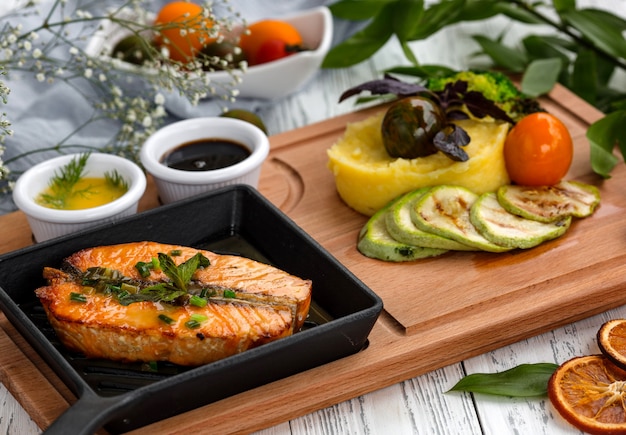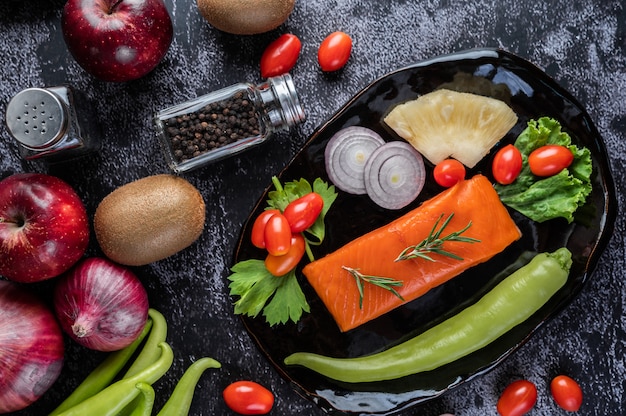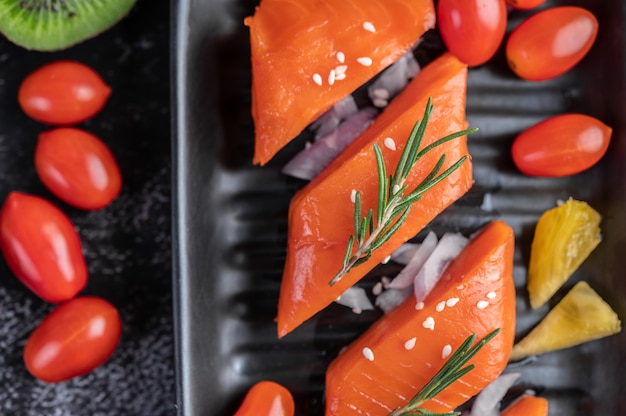Let's face it, we've all been there - that moment of disappointment when you bite into a piece of salmon that's dry, overcooked, and lacking the beautiful flakiness that makes it so irresistible. But fear not, my fellow food enthusiasts! You're about to unlock the secrets to grilling salmon that's not only delicious but also a visual masterpiece. I'm going to share my hard-earned wisdom, gathered over years of experimentation and countless grilled salmon feasts, to help you achieve that coveted perfect flakiness. From choosing the right salmon to mastering the art of the grill, this guide will transform you from a salmon-grilling novice to a bona fide grill master. So, grab your apron, gather your ingredients, and let's dive into the world of grilled salmon perfection!
(Part 1) The Salmon Chronicles: Choosing Your Weapon

The journey to amazing grilled salmon begins with selecting the right fish. Now, I'm not talking about picking the freshest fish from the market (although that's definitely a good idea!), but rather understanding the different types and qualities that will set you up for success.
Salmon 101: A Breakdown of the Best
The world of salmon can feel a bit overwhelming, but I'm here to simplify it for you. There are two main categories you need to consider:
- Wild vs. Farmed: This is a classic debate, and both options have their merits. wild salmon often boasts a richer flavour and a firmer texture, but it can be harder to find and more expensive. farmed salmon is readily available and generally more affordable, but might lack the intense flavour of its wild counterpart. Ultimately, the choice is yours, based on your preferences and budget.
- types of salmon: Within each category (wild or farmed), you'll find various types of salmon, each with its unique flavour and characteristics.
- atlantic salmon: This is the most common type, known for its rich flavour and a firm texture. You'll find it readily available in both wild and farmed varieties.
- sockeye salmon: This salmon stands out for its intense, deep red colour and a buttery, rich flavour. It's generally considered a wild variety, often hailed as a superior choice.
- King Salmon (Chinook): This is the largest of the pacific salmon, boasting a robust flavour and a dense, flaky texture. It's generally a wild variety and is highly prized for its quality.
- coho salmon: This salmon offers a mild flavour and a slightly firmer texture than sockeye or King salmon. It's available in both wild and farmed varieties.
- Size Matters: For grilling, you'll want to choose a fillet that's around 1-1.5 inches thick. This will ensure even cooking and prevent the fish from drying out. Think of it as the Goldilocks principle of salmon – not too thin, not too thick, just right!
Personally, I've found that even farmed salmon can be incredibly delicious when prepared and cooked correctly. It's all about mastering the techniques, and I'm here to guide you through it! But if you're seeking that truly wild salmon flavour, then don't hesitate to splurge on the good stuff.
(Part 2) Preparing for the Battle: Getting Your Salmon Ready

Now that you've got your salmon selected, it's time to get your hands dirty and prep it for grilling. This is where we transform that raw fish into a potential culinary masterpiece.
The Art of Skinning and Scaling
First things first, let's address the salmon's skin. It can be a bit of a decision point. Here's the deal:
- Leave it on: This method is a bit more traditional and can help keep the salmon moist and prevent it from sticking to the grill. Just make sure to score the skin with a sharp knife to prevent it from curling up during cooking.
- Take it off: If you're feeling fancy or want a skinless presentation, you can remove the skin. Be careful not to break the fish during this process, which can be a bit tricky for beginners.
And don't forget those pesky scales! If they're still clinging on, use a fish scaler (a handy tool you can find at most kitchen supply stores) or a sharp knife to remove them. You don't want to be crunching on those when you're enjoying your perfectly grilled salmon.
Seasoning with Love: A Symphony of Flavours
Now, this is where the real fun begins! Seasoning salmon is like painting a masterpiece – it's about creating a symphony of flavours that enhance, not overpower, the natural taste of the fish. I've spent years experimenting, and here are a few of my favourite seasoning blends:
- Simple is Best: Salt and pepper, a classic for a reason. It lets the natural flavours of the salmon sing. Add a squeeze of fresh lemon juice for a touch of brightness and tang.
- Mediterranean Magic: A sprinkle of dried oregano, thyme, and rosemary, a drizzle of high-quality olive oil, and a pinch of red pepper flakes transport your salmon to the shores of the Mediterranean.
- Asian Inspiration: A mixture of soy sauce, fresh ginger, and sesame oil creates a flavour explosion that's sure to impress. A touch of brown sugar adds a hint of sweetness, balancing the salty and savory notes.
- Citrus Burst: A zesty mix of lemon and orange zest, a touch of garlic, and a sprinkle of fresh herbs like dill or parsley adds a bright and fragrant element to your salmon.
Remember, these are just starting points. Feel free to experiment, combine flavours, and discover your own signature salmon seasoning. Don't be afraid to get creative and have fun! The possibilities are endless.
(Part 3) The Grilling Game: Mastering the Art of the Flame

Now, we're getting to the heart of the matter - the actual grilling process. This is where you'll transform your seasoned salmon into a flaky, flavorful masterpiece. It's a dance between heat and fish, and it takes a little practice to get it right. But don't worry, I'll guide you through it step by step.
The Perfect Grill: Finding Your Match
Before you begin, you'll need the right tool for the job. I highly recommend a gas grill for consistent heat control, making it easier to achieve that perfect cook. However, a charcoal grill can also deliver amazing results, adding a smoky flavour that elevates your salmon to another level. No matter which type you choose, make sure it's clean and preheated to medium-high heat before you start grilling.
Grill Marks and Flakiness: A Beautiful Partnership
Here's the secret to achieving that stunning visual appeal and delicious texture: You want to create beautiful grill marks without overcooking the fish. Place your salmon skin-side down on the hot grill. This not only adds a lovely char to the skin but also helps prevent the fish from sticking. Let it cook for about 3-4 minutes, or until you get a nice crust.
Then, carefully flip the salmon over and cook for another 3-4 minutes. The goal is to achieve a beautiful pink centre, not a dry, grey mess. Pay attention to the edges of the salmon - they should start to flake easily, indicating it's nearing done.
internal temperature: The Key to Success
Don't be a salmon sceptic! An instant-read thermometer is your best friend. It's the most reliable way to ensure your salmon is cooked to perfection. You want it to reach an internal temperature of 145°F (63°C). This ensures that the fat is rendered, creating that succulent flakiness, while also ensuring the fish is safe to eat.
(Part 4) Beyond the Grill: Finishing Touches and Serving
Your salmon is cooked to perfection, but we're not quite finished yet! There are some crucial finishing touches that will elevate your dish to new heights.
The Power of Resting: Letting the Salmon Relax
Resist the urge to serve your salmon immediately after grilling. Let it rest for 5-7 minutes before slicing and serving. This allows the internal juices to redistribute throughout the fish, resulting in a more tender and succulent texture. It also allows the salmon to cool slightly, making it safer to handle and easier to slice.
Serving with Style: Elevating the Salmon Experience
Now that your salmon is rested and ready, it's time to dress it up for the grand finale. Serve it up with a side of your favourite grilled vegetables, rice, quinoa, or pasta.
Here are a few of my favourite accompaniments:
- roasted asparagus: The bitterness of the asparagus complements the richness of the salmon perfectly.
- Sautéed Spinach with Garlic: A simple and flavourful side dish that complements the salmon beautifully.
- Lemon-Dill Sauce: This zesty sauce adds a touch of brightness to the salmon and enhances its natural flavours.
- grilled corn on the Cob: Sweet and smoky, corn on the cob is a classic summer companion for grilled salmon.
Tips for Presentation: Turning Up the Heat
Here are a few tips for serving your salmon like a pro:
- Slicing with Precision: Use a sharp knife to slice the salmon into neat, even pieces. Avoid pressing down on the knife, which can crush the delicate texture.
- Art on a Plate: Arrange the salmon on a serving platter or individual plates and garnish with fresh herbs, lemon wedges, or a sprinkle of toasted sesame seeds. A sprig of fresh dill or a few lemon slices add a pop of colour and freshness.
(Part 5) The Grilled Salmon Buffet: A Feast for the Senses
Now, you might be thinking, "That sounds amazing, but what can I do with all this grilled salmon?" Fear not, my friends, because the possibilities are endless! Here are a few ideas to get your creative juices flowing, transforming your grilled salmon into a versatile star of your culinary repertoire.
From Dinner to Lunch: The Versatile Salmon
- Grilled Salmon Salad: Combine flaked salmon with your favourite salad greens, vegetables, and a light dressing. A simple vinaigrette or a creamy avocado dressing would work beautifully.
- Salmon Tacos: Top your tacos with grilled salmon, salsa, guacamole, and your favourite toppings. Think shredded cabbage, cilantro, lime juice, or even a dollop of sour cream for added richness.
- Salmon Sandwiches: Make a simple yet satisfying sandwich by layering grilled salmon, avocado, and cream cheese on toasted bread. Add a touch of spice with a few slices of jalapeno pepper or a drizzle of sriracha mayo.
Beyond the Basics: Exploring New Flavours
If you're feeling adventurous, try these unique variations:
- Grilled Salmon with Mango Salsa: The sweetness of the mango salsa perfectly complements the rich flavour of the salmon.
- Grilled Salmon with Balsamic Glaze: A drizzle of balsamic glaze adds a touch of sweetness and acidity to the salmon. You can even make your own glaze by reducing balsamic vinegar with a bit of honey or brown sugar.
- Grilled Salmon with Pesto: A dollop of pesto adds a vibrant, herbaceous flavour to the salmon. Try basil pesto for a classic flavour or experiment with other herbs like arugula or cilantro.
- Grilled Salmon with Chipotle Mayo: For a smoky, spicy kick, try topping your salmon with chipotle mayo.
(Part 6) The Secrets of Flakiness: Unveiling the Truth
Now, let's dive deeper into the science behind that incredible, mouth-watering flakiness that makes grilled salmon so irresistible. It's not just about cooking techniques; it's about understanding the composition of the fish itself.
The Science of Salmon: Unraveling the Mystery
Salmon is a fatty fish, and that fat content plays a crucial role in its texture. As the salmon cooks, the fat breaks down, creating steam that helps to separate the muscle fibres, resulting in that characteristic flaky texture. It's a beautiful chemical reaction that transforms a firm fillet into a tender, delicate masterpiece.
Here's the key takeaway: It's not just about the fat content; it's also about the cooking process. Too much heat and the fat will cook too quickly, leaving you with a dry, tough salmon. Cook it too slowly, and the muscle fibres won't break down properly, resulting in a dense, chewy texture. It's all about finding that perfect balance between heat and time.
The Key to Flakiness: Timing is Everything
Now, you've got the science, but what does that mean in practice? It means you need to keep a close eye on your salmon and use a thermometer to make sure it's cooked to perfection.
Remember, the goal is to cook the salmon to an internal temperature of 145°F (63°C). This ensures that the fat is rendered but the protein isn't overcooked.
(Part 7) Avoiding Salmon Catastrophes: Common Mistakes and Solutions
We've all been there, haven’t we? The dreaded dry salmon, the overcooked disaster. But don't worry, I've got you covered. Here are a few common mistakes and how to avoid them, turning your potential salmon calamities into triumphs.
overcooked salmon: The Dry and Unforgiving
- The Cause: Too much heat or cooking for too long.
- The Solution: Use a thermometer to make sure your salmon is cooked to the right internal temperature. And don't be afraid to take it off the grill a few minutes early if it seems like it's getting too dry.
Undercooked Salmon: A Risky Proposition
- The Cause: Not cooking the salmon long enough.
- The Solution: Use a thermometer to make sure your salmon is cooked to the right internal temperature. And don’t be afraid to cook it for a few extra minutes if it’s not quite there yet.
Salmon Sticking to the Grill: A Sticky Situation
- The Cause: Not enough oil on the grill or the salmon isn't scored.
- The Solution: Make sure your grill is well-oiled before you start cooking. And score the skin of the salmon to prevent it from curling up.
Burnt Salmon: A Bitter Truth
- The Cause: Too much heat or the salmon is sitting directly over the flame.
- The Solution: Lower the heat on your grill or move the salmon to a less direct area. You want the salmon to cook slowly and evenly.
(Part 8) FAQs: Unveiling the Mysteries of Grilled Salmon
Q1: What is the best way to store salmon?
The best way to store salmon is in the refrigerator, wrapped tightly in plastic wrap or aluminum foil. It should last for 1-2 days. You can also freeze salmon for up to 3 months, but it may lose some of its texture and flavour when thawed. If freezing, wrap it tightly in plastic wrap and then in aluminum foil to prevent freezer burn.
Q2: Can I grill salmon on a gas grill?
Absolutely! Gas grills are perfect for grilling salmon because they offer consistent heat control. Just make sure to preheat your grill to medium-high heat before you start cooking. If you're using a gas grill, use a grill brush to clean the grates before heating.
Q3: How can I tell if salmon is cooked through?
The best way to tell if salmon is cooked through is to use a thermometer. The internal temperature should reach 145°F (63°C). You can also check the colour of the fish: the flesh should be opaque and flake easily with a fork. If you're unsure, it's always better to err on the side of caution and cook it a bit longer.
Q4: What are some good side dishes for grilled salmon?
There are tons of great side dishes for grilled salmon! Some of my favourites include roasted vegetables, rice, quinoa, and pasta. You can also serve it with a light salad or a simple sauce, like lemon-dill or pesto. Consider a side dish that balances the richness of the salmon, like a bright and tangy salad or a roasted vegetable that offers a contrasting flavour.
Q5: What are some tips for making the most flavorful grilled salmon?
Here are a few tips for making the most flavorful grilled salmon:
- Marinate the salmon for at least 30 minutes before grilling. This will help to infuse the fish with flavour. Use a marinade that complements the salmon's natural flavour, like a citrusy marinade with lemon or lime, or a soy sauce-based marinade with ginger and garlic.
- Don’t overcook the salmon. Cook it just until it’s flaky and moist. Overcooking can lead to a dry, rubbery texture.
- Serve the salmon with a side of your favourite grilled vegetables or a light sauce.
Now go forth and grill your way to salmon perfection! I'm confident that after reading this guide, you'll be grilling the most delicious, flaky salmon you've ever tasted. Remember, practice makes perfect, so don't be afraid to experiment and find what works best for you. Happy grilling!
Everyone is watching

Prime Rib Roast Cooking Time Chart: Per Pound Guide
Cooking TipsPrime rib roast. Just the name conjures images of lavish dinners, crackling fires, and hearty laughter. It’s ...

How Long to Bake Potatoes in the Oven (Perfect Every Time)
Cooking TipsBaked potatoes are a staple in my kitchen. They're incredibly versatile, delicious, and surprisingly easy to m...

Perfect Rice Every Time: The Ultimate Guide to Cooking Rice
Cooking TipsAs a self-proclaimed foodie, I've always been a bit obsessed with rice. It's the foundation of countless cuisi...

The Ultimate Guide to Cooking Asparagus: Tips, Techniques, and Recipes
Cooking TipsAsparagus. The mere mention of this spring delicacy conjures up images of vibrant green spears, crisp and burs...

Ultimate Guide to Cooking the Perfect Thanksgiving Turkey
Cooking TipsThanksgiving. Just the word conjures up images of overflowing tables laden with delicious food, the scent of r...
